
Changing your IP address can improve your privacy, resolve network issues, or even bypass certain restrictions. In this tutorial, we’ll walk you through the steps to change your IP address on Windows 10 and 11. Whether you’re using an Ethernet or wireless connection, this guide will cover everything you need to know.
Key Takeaways
- Learn how to manually change your IP address on both Windows 10 and Windows 11.
- Understand the difference between DHCP-assigned IP addresses and static IP addresses.
- Get tips on using Google’s DNS for faster and more reliable connections.
1. Accessing the Control Panel

- From your desktop, click the Start button or press the Windows key + S to open the search bar.
- Type in “Control Panel” and select the best match.
- In the Control Panel, change the view to Small Icons for easier navigation.
2. Navigate to Network and Sharing Center

- Once in the Control Panel, find and click on Network and Sharing Center.
- On the left side, select Change Adapter Settings to view all network adapters on your system.
3. Selecting the Correct Network Adapter

- Identify the network adapter you’re using. If you’re on a desktop, this is typically labeled Ethernet.
- For laptops or devices using Wi-Fi, look for the wireless network adapter.
Example: If you’re using a VPN like ProtonVPN, you might see additional adapters like Ethernet 3 for VPN connections. Ignore these and focus on your main network adapter.
4. Viewing Current Network Settings

- Right-click on your network adapter and select Status.
- Click on Details to view your current network connection settings. Pay attention to the IPv4 address and whether DHCP is enabled.
5. Changing Your IP Address

- Close the details window and select Properties for your network adapter.
- In the list of options, find Internet Protocol Version 4 (TCP/IPv4) and double-click it.
- Choose Use the following IP address to manually enter a new IP.
6. Finding an Available IP Address

- Open PowerShell as an administrator (or Command Prompt, depending on your setup).
- Type
IPConfigand press Enter to see all assigned IP addresses. - To find an available IP address, use the command
arp -a, which will list all IP addresses on your network.Pro Tip: Make sure the IP address you choose isn’t already in use to avoid conflicts. The range is typically from 192.168.x.2 to 192.168.x.255, with your router usually assigned to .1.
7. Entering Your New IP Address

- Back in the Internet Protocol settings, enter the new IP address you’ve selected.
- The Subnet Mask field should fill automatically. If not, it is usually 255.255.255.0 for home networks.
- Enter your router’s IP address as the Default Gateway (you can find this in the IPConfig results or typically set to 192.168.x.1).
- For DNS Servers, you can use Google’s DNS by entering 8.8.8.8 and 8.8.4.4 for faster, reliable resolution.
8. Confirming Your New IP Address

- After applying the changes, right-click your network adapter again and choose Status.
- Click Details to verify your new IP address and ensure that DHCP is disabled, confirming you’ve set a static IP.
9. Reverting to a DHCP IP Address (Optional)

- If you need to switch back to a dynamically assigned IP address, simply return to the Internet Protocol settings and choose Obtain an IP address automatically.
- You can also revert your DNS settings to be assigned automatically by the router.
Why Change Your Local IP Address?

Changing your local IP address can be useful for several reasons related to your device’s interaction within your local network:
- Avoid Network Conflicts: If two devices on the same network accidentally share the same IP address, it can cause connectivity issues. Changing your local IP address can resolve these conflicts and ensure smooth network performance.
- Better Device Management: Assigning a static local IP address to a device, like a printer or a server, can make it easier to manage and access consistently within your network.
- Improved Local Security: In some cases, changing your local IP address can help protect your device from being easily targeted by others on the same network. This can add an extra layer of security in shared or public networks.

Remember, changing your local IP address only affects how your device is identified within your local network and does not change your public IP address, which is assigned by your Internet Service Provider (ISP). However, your public IP can be changed with a VPN like ProtonVPN.
Conclusion
Changing your IP address on Windows 10 or 11 can be an essential skill for managing your network and protecting your privacy. Whether you’re switching to a static IP or troubleshooting network issues, these steps should help you achieve your goals. Remember to choose IP addresses carefully and verify changes to avoid conflicts.
FAQs
1. What is the difference between a dynamic and static IP address?
A dynamic IP is automatically assigned by your router, while a static IP is manually set by the user and does not change unless done so manually.
2. Can changing my IP address affect my internet connection?
Yes, if done incorrectly. Choosing an IP address that’s already in use can lead to conflicts, resulting in no network access.
3. Is it safe to use Google’s DNS?
Yes, Google’s DNS is considered safe and can even speed up your browsing experience. The addresses are 8.8.8.8 and 8.8.4.4.
4. Will this process work on other versions of Windows?
The steps are similar for Windows 8, but this guide is specifically for Windows 10 and 11. Windows 7 has a different interface but follows a similar logic.
5. Can I change my public IP address using this method?
No, this tutorial changes your local IP address on your network. To change your public IP, you usually need to contact your ISP or use a VPN.

In a computer network, every device connected to the Internet has an IP (Internet Protocol) address. This unique identifier allows devices to communicate with each other. Windows 10 and other operating systems automatically assign an IP address using DHCP (Dynamic Host Configuration Protocol). However, in some cases, you may need to find your current IP address or manually assign a static IP address for better control over network settings. in this article we will tell you how to change ip address windows 10 in simple steps.
How to Find Your IP Address on Windows 10
Finding your IP address on Windows 10 is easy. You can check both your private (local) IP address and public IP address using different methods.
Method 1: Using Command Prompt
- Press Windows + R, type cmd, and hit Enter.
- In the Command Prompt window, type ipconfig command and press Enter.
- Look for the section labeled Wireless LAN adapter (for Wi-Fi) or Ethernet adapter (for a wired connection).
- Find the IPv4 Address. This is your local IP address.
Method 2: Using Network Settings
- Click on the Start Menu and go to Settings. or click Windows + I from keyboard
- Select Network & Internet.
- Choose Wi-Fi (for wireless) or Ethernet (for wired connections).
- Click on the active network connection.
- Scroll down to find the IPv4 address.
Manually assigning IP address on Windows 10 can help you set up static IP for better network management.
Step 1: Open Network Settings
- Press Win + R to open the Run dialog box.
- Type ncpa.cpl command and hit Enter to open the Network Connections window System.
Step 2: Select Your Network Adapter
- Identify the network adapter you are using (e.g., Wi-Fi or Ethernet).
- Right-click on your active network connection (Ethernet) and select Properties Option.
Step 3: Open IPv4 Settings
- In the Networking tab, scroll down and find Internet Protocol Version 4 (TCP/IPv4).
- Select it and click the Properties button.
Step 4: Assign a Static IP Address
- In the General tab, select Use the following IP address.
- Enter the following details:
- IP Address: Choose an address within your network range (e.g.,
192.168.1.100). - Subnet Mask: Typically,
255.255.255.0. - Default Gateway: Usually your router’s IP (e.g.,
192.168.1.1).
- IP Address: Choose an address within your network range (e.g.,
Step 5: Configure DNS Settings
- Select Use the following DNS server addresses.
- Enter your local DNS Address Or google DNS Address
- Preferred DNS server:
8.8.8.8(Google DNS) or your ISP’s DNS. - Alternate DNS server:
8.8.4.4(Google DNS) or another backup.
- Preferred DNS server:
Step 6: Apply and Confirm
- Click OK to save changes.
- Close all windows and restart your computer to apply the new IP settings.
Verifying the Static IP Assignment
After manually assigning a static IP address in Windows 10, follow these steps to verify that the changes were applied correctly.
- Press Win + R, type cmd, and press Enter to open the Command Prompt.
- Type the command: ipconfig /all
- Ensure the IPv4 address matches what you assigned.
- Test network connectivity by pinging your router: like
ping 192.168.1.1If you receive replies, your connection is successful.
Troubleshooting Common Issues
- IP Conflict: If another device is using the same IP address, change it to avoid network issues.
- No Internet Connection: Verify that the default gateway is set correctly.
- Unable to Save Settings: Ensure you have administrative privileges.
- Flushing DNS Cache: Run
ipconfig /flushdnsin Command Prompt if there are DNS resolution issues.
Conclusion
Finding and manually assigning an IP address on Windows 10 is useful for managing network settings, improving stability, and setting up custom configurations. By following these simple steps, you can easily configure your computer’s IP address to suit your needs. If you ever encounter network issues, reverting to automatic settings is just as easy. With this guide, you now have full control over your network connections on Windows 10.
Recommened Articles
- About
- Latest Posts
Перед тем как менять параметры IP самостоятельно, рекомендуем куда-то записать текущие значения, поскольку они могут пригодиться во время редактирования, а также на случай, когда потребуется вернуть предыдущие адреса.
Способ 1: «Параметры»
Обычно компьютеру автоматически присваивается IP-адрес провайдером. Но изменить его параметры можно вручную с помощью соответствующего раздела в системных «Параметрах». Этот вариант, скорее, подойдет для проводного типа соединения, когда ПК или ноутбук напрямую подсоединен к маршрутизатору:
- Нажмите на кнопку «Пуск», затем выберите приложение «Параметры».
- Перейдите в раздел «Сеть и Интернет».
- Нажмите на вкладку слева «Ethernet», а в центральной части окна выберите активное соединение.
- Пролистайте до блока «Параметры IP» и кликните по кнопке «Редактировать».
- Во всплывающем окне нажмите на выпадающее меню и выберите пункт «Вручную».
- Отобразятся два варианта для изменения: «IPv4» и «IPv6». Чтобы изменить тот или иной протокол, переведите тумблер в активное состояние.
- Появятся дополнительные текстовые поля для ручного ввода параметров: IP-адрес, сервера DNS, шлюз и длина префикса подсети. Как только все данные будут введены, нажмите на кнопку «Сохранить».
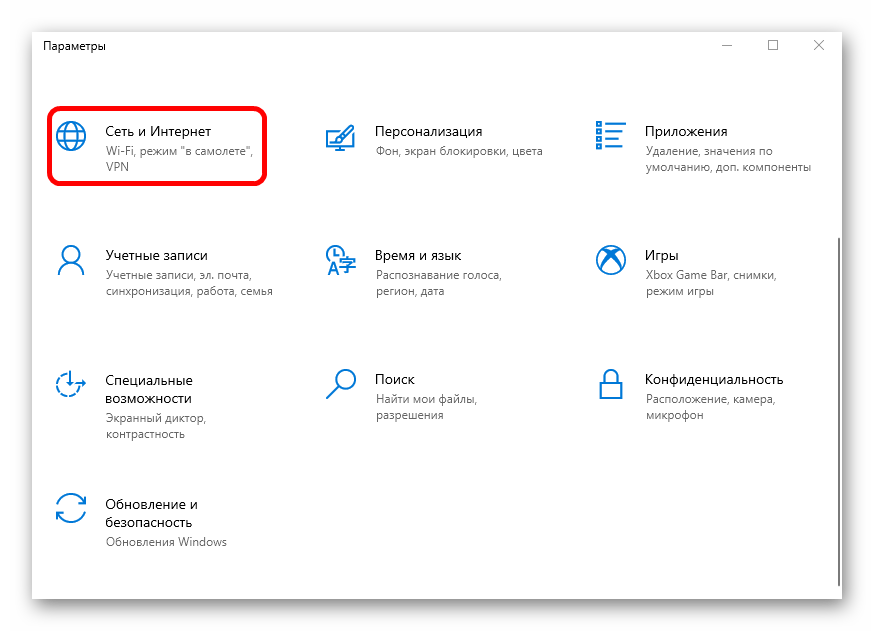
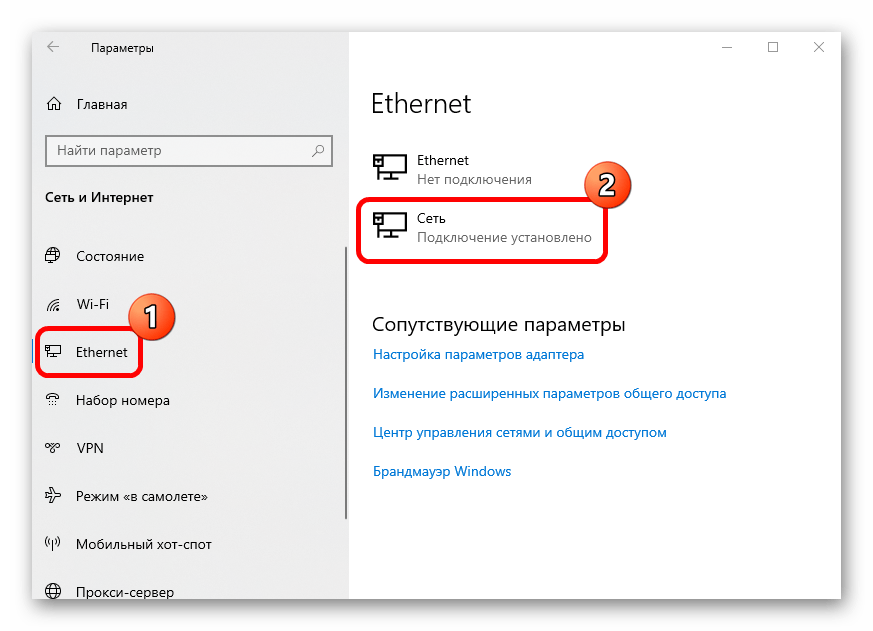
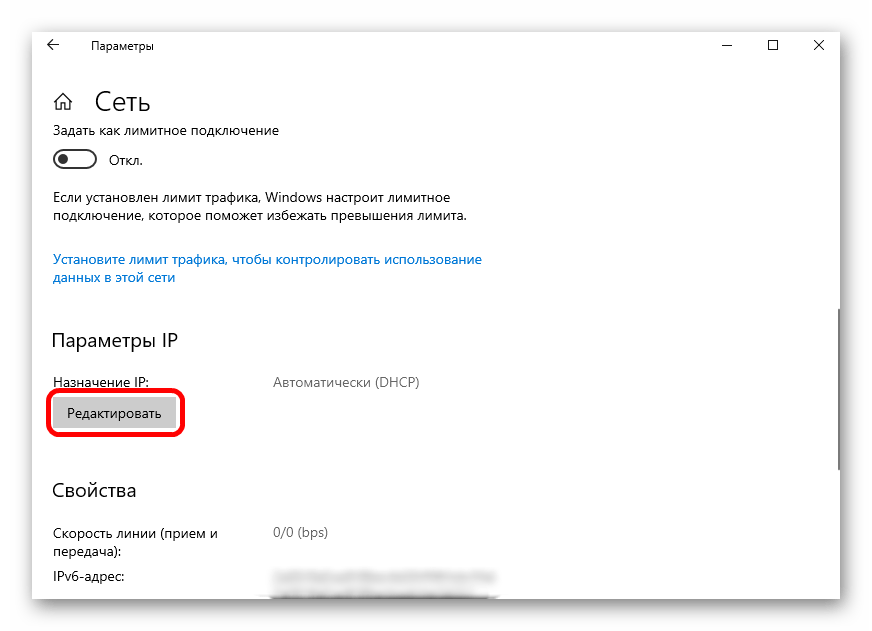
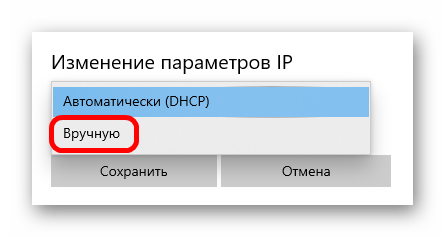
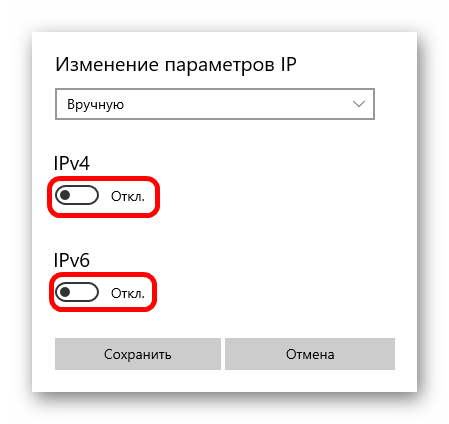
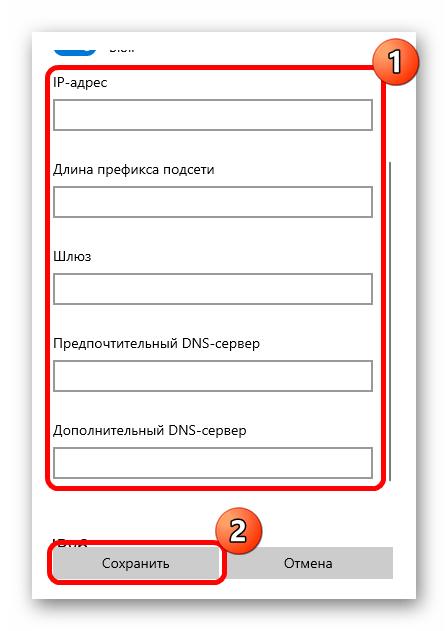
Следует отметить, что при редактировании параметров необходимо быть уверенным, что все данные верны, иначе подключение к интернету может быть нарушено. Если у вас не получается сохранить новые параметры, то ознакомьтесь с нашей отдельной инструкцией:
Подробнее: Что делать, если не удается сохранить параметры IP-адреса в Windows 10
Способ 2: «Свойства сетевого адаптера»
Этот метод классический, поскольку используется «Панель управления», свойственная и предыдущим Windows. Через нее нужно перейти в окно с настройкой свойств сетевого адаптера:
- Через строку системного поиска отыщите средство «Панель управления».
- Для удобства просмотра разделов выберите «Крупные значки» в верхнем правом углу, затем перейдите в «Центр управления сетями и общим доступом».
- В новом окне щелкните по ссылке «Изменение параметров адаптера» на левой панели.
- Отобразится список всех подключений, которые были на ПК или ноутбуке. Отыщите нужное, затем щелкните по нему правой кнопкой мыши и из меню выберите пункт «Свойства».
- На вкладке «Сеть» выделите нажатием левой кнопкой мыши пункт «IP версии 4 (TCP/IPv4)», а потом кликните по кнопке «Свойства».
- Поставьте отметку у опции «Использовать следующий IP-адрес», после чего ниже поля станут доступными для редактирования. Введите нужные значения. Так же можно поступить и со сменой DNS-сервера. Сохраните настройки.
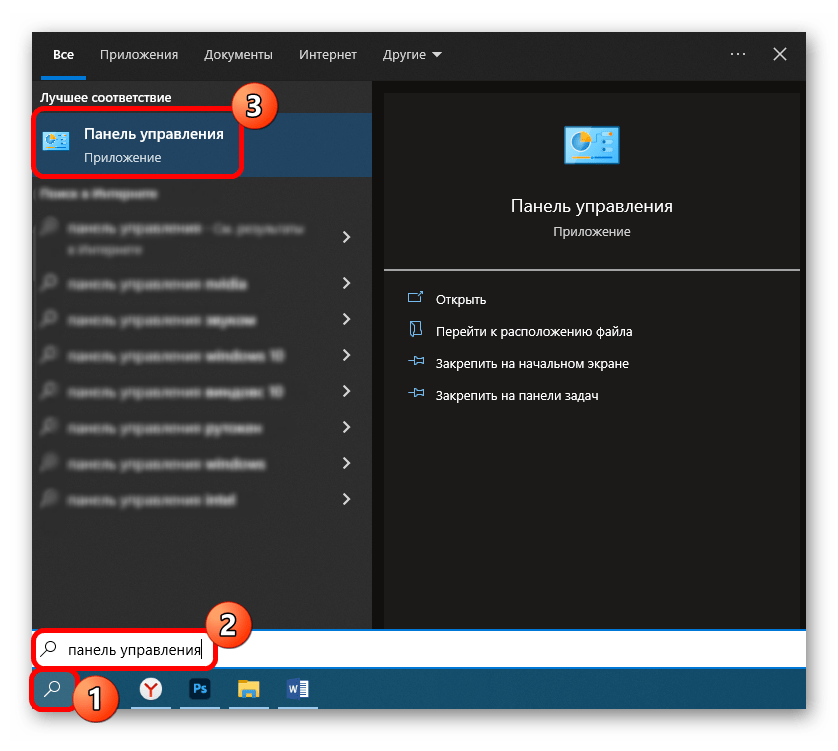
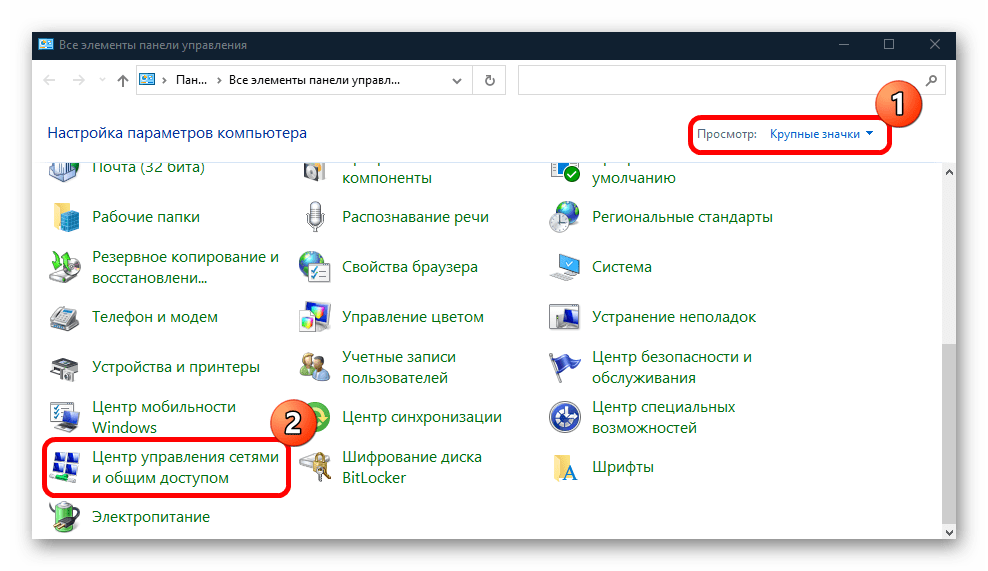
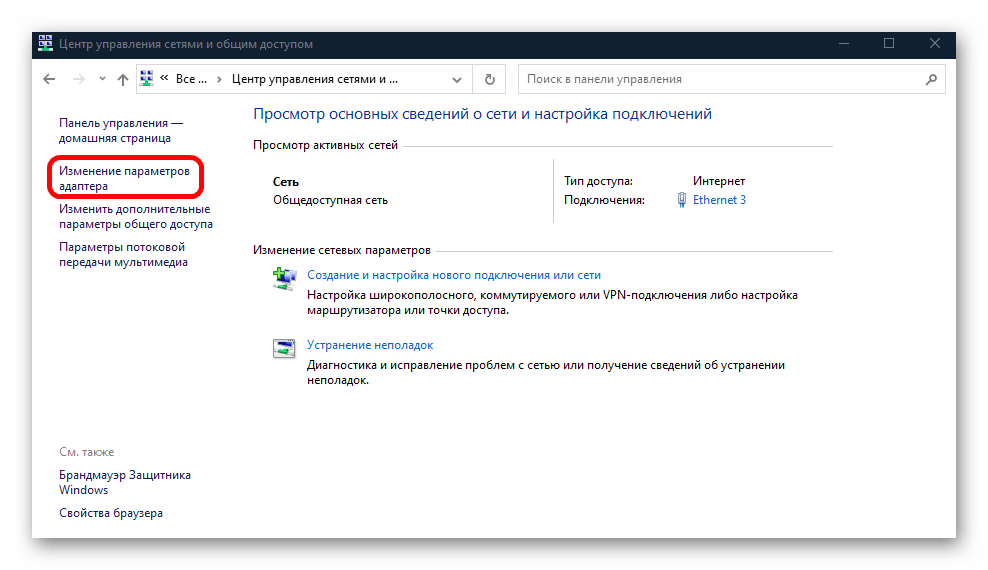
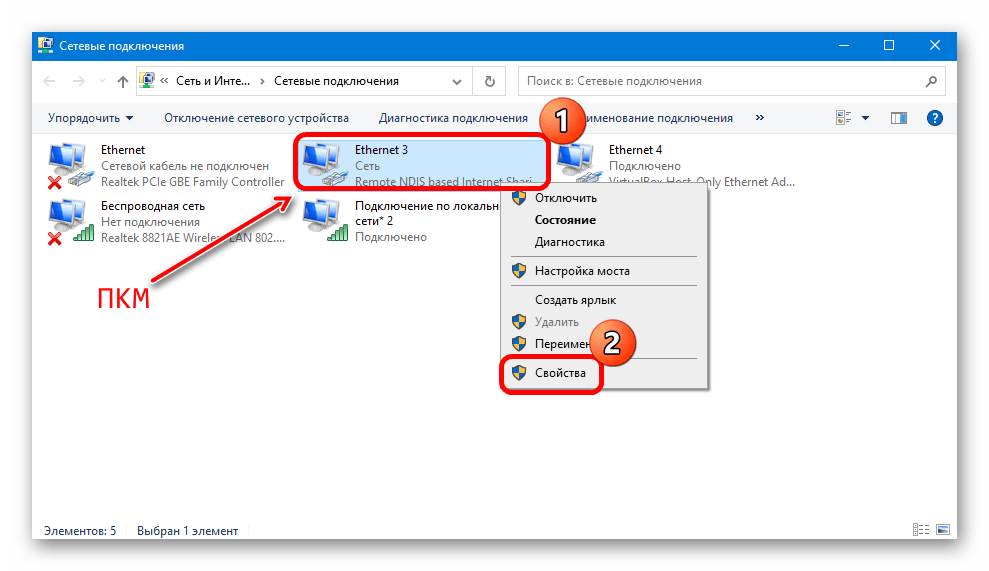
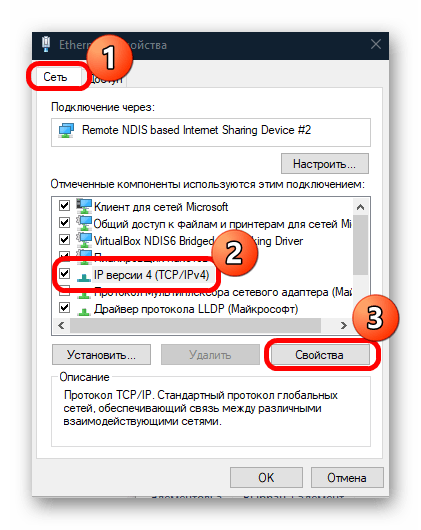
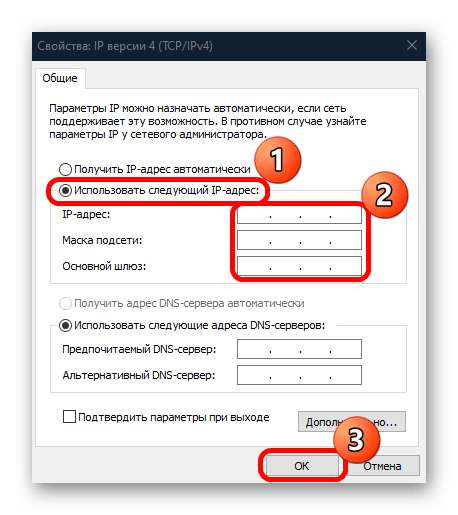
Аналогичные действия при необходимости есть возможность проделать и с протоколом «IP версии 6 (TCP/IPv6)», выбрав его в списке окна со свойствами сети.
Способ 3: «Командная строка»
Изменить некоторые параметры IP, в частности статический IP-адрес и DNS-сервер, можно, используя команды. Зная их, не придется копаться в настройках, что может сэкономить время:
- Запустите «Командную строку» от имени администратора. Для этого воспользуйтесь поисковой строкой на нижней панели.
- Чтобы посмотреть все конфигурации сетевых адаптеров, введите команду
ipconfig /allи нажмите на клавишу «Enter». В списке отыщите тот адаптер, параметры IP которого собираетесь изменить. - Чтобы задать сетевому адаптеру статический IP-адрес, вставьте
netsh interface ip set address name="Ethernet" static 192.168.1.10 255.255.255.0 192.168.1.1, где нужно прописать свои параметры: вместо «Ethernet» – имя вашего адаптера, а цифры обозначают данные IP-адресов. Выполните команду клавишей ввода. - Далее можете заменить предпочитаемый и альтернативный DNS-серверы, поочередно выполнив команды
netsh interface ip set dns name="Ethernet" source="static" address="адрес_DNS-сервера"иnetsh interface ip add dns name="Ethernet" address="адрес_DNS-сервера" index=2, не забывая прописывать вместо «Ethernet» и цифр свои данные.
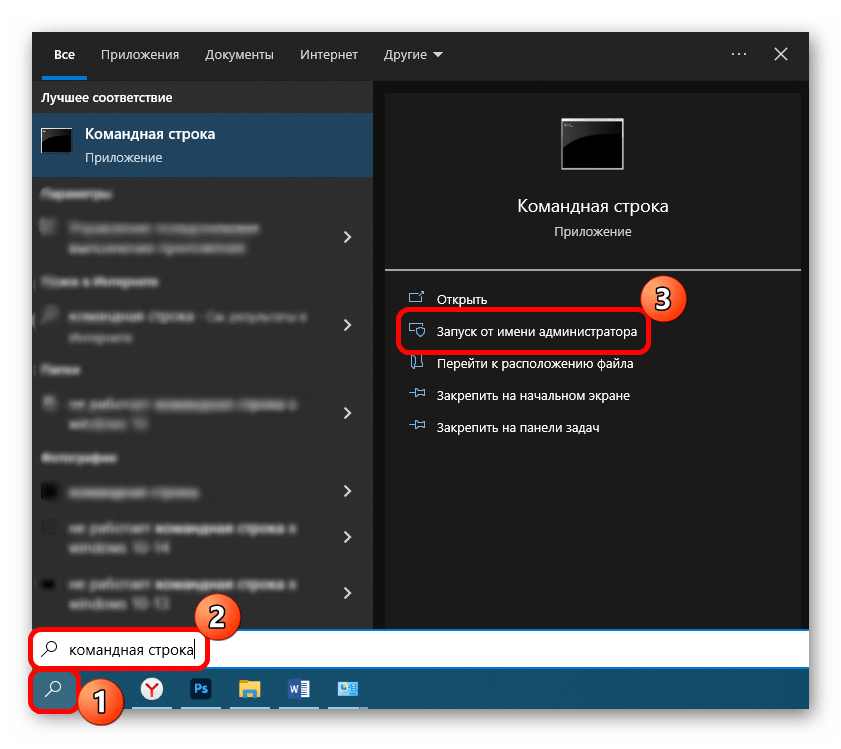
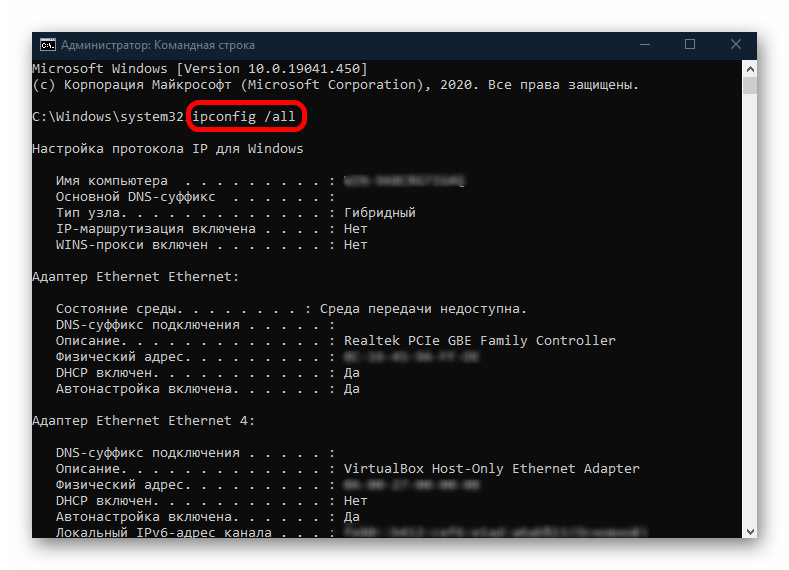
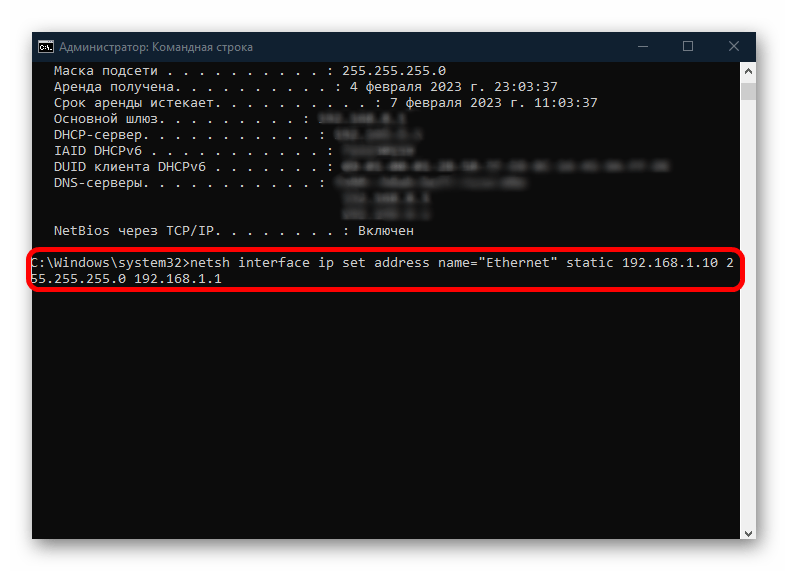
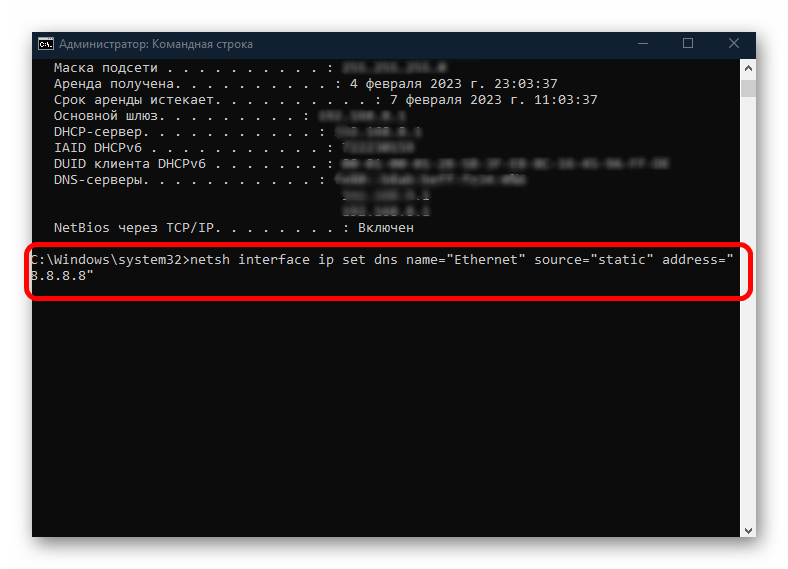
То же самое можно проделать и через консоль «Windows PowerShell», запущенную с расширенными правами.
Наша группа в TelegramПолезные советы и помощь
Changing your IP address on a Windows 10 computer using the Command Prompt (CMD) is easier than it sounds. By following a few straightforward steps, you can navigate through the process without any hiccups. Here’s a quick rundown: open CMD with admin rights, find your network interface name, release the current IP, and then renew it. That’s basically it!
In this section, we’ll dive into the complete steps for changing your IP address using CMD on a Windows 10 computer. These steps will help you release your old IP address and get a new one.
Step 1: Open Command Prompt as Administrator
The first thing you need to do is open the Command Prompt with admin rights.
Right-click on the Start menu and select ‘Command Prompt (Admin)’ or ‘Windows PowerShell (Admin)’ to open it with administrative privileges.
Step 2: Find Your Network Interface Name
Next, you need to find the name of your network interface.
Type ipconfig /all and press Enter. Look for the name of your active network adapter, usually something like «Ethernet» or «Wi-Fi.»
Step 3: Release the Current IP Address
Now, you’ll release the current IP address.
Type ipconfig /release and press Enter. This command will make your current IP address free for others to use.
Step 4: Renew the IP Address
Finally, get a new IP address.
Type ipconfig /renew and press Enter. This command will ask your router for a new IP address, and assign it to your computer.
Once these steps are completed, your computer will have a new IP address. You can verify this by typing ipconfig again and checking the IP details for your network adapter.
Tips for Changing IP Address Windows 10 CMD
Here are a few useful tips to help you out:
- Use Administrator Privileges: Always run the Command Prompt as an administrator to avoid permission issues.
- Network Adapter Name: Make sure you’re targeting the correct network adapter, especially if you have multiple ones.
- Double-Check Commands: A simple typo can result in errors, so double-check each command before hitting Enter.
- Restart if Necessary: Sometimes, a reboot can help if the changes don’t take effect immediately.
- Backup Settings: Note down current settings before making changes, just in case you need to revert.
Frequently Asked Questions
Why should I change my IP address?
Changing your IP address can help resolve network conflicts and security issues.
Will this affect my Internet connection?
Briefly, yes. Your connection will temporarily drop when you release your IP, but it will restore once you renew it.
Can I choose a specific IP address?
Using ipconfig /renew automatically assigns a new IP. For a specific one, you’d need to configure it in your network settings.
Do these steps work on all networks?
Generally, yes. However, some networks with static IP configurations might require additional steps.
What if I get an error message?
Double-check your command syntax and make sure you have administrative rights. Restarting your computer can also help.
Summary
- Open Command Prompt as Administrator
- Find Your Network Interface Name
- Release the Current IP Address
- Renew the IP Address
Conclusion
Changing your IP address on Windows 10 using CMD is a simple and effective way to manage your network settings. Not only does it help in resolving network issues, but it also adds an extra layer of security. Whether you’re troubleshooting or just want a fresh start, knowing how to change your IP address is a useful skill.
Feel confident diving into your Command Prompt and playing around with IP settings. And remember, if things don’t go as planned, a quick reboot or revisiting these steps should set things right. For those who love to dig deeper, learning about static IP configurations might be your next adventure.
So, go ahead and give it a try! Who knows, you might just become the go-to tech expert in your circle!
Kermit Matthews is a freelance writer based in Philadelphia, Pennsylvania with more than a decade of experience writing technology guides. He has a Bachelor’s and Master’s degree in Computer Science and has spent much of his professional career in IT management.
He specializes in writing content about iPhones, Android devices, Microsoft Office, and many other popular applications and devices.
Read his full bio here.
Have you ever wondered how to change the IP address in Windows 10 or Windows 11? Do you want to learn how to do that from the Settings app or the Control Panel? Maybe you’re a command-line fan and want to learn how to change the IP address from Command Prompt or PowerShell? Read on and find out how all of these are done in both Windows 11 and Windows 10:
NOTE: To be able to change your IP address in either Windows 10 or Windows 11, you must log in using an administrator account. Also, you should already know what IP addresses and subnet masks are, how to find what your local IP is, and how to find the IP address of your router.
1. How to change the IP address in Windows 10 using the Settings app
Because it relies on the visual interface of the operating system, this is probably the easiest method for changing the IP address of your Windows 10 computer or device. First, open the Settings app: a quick way to do that is to push the Settings button from the Start Menu or to press Windows + I on your keyboard simultaneously. In the Settings app, open the Network & Internet category.
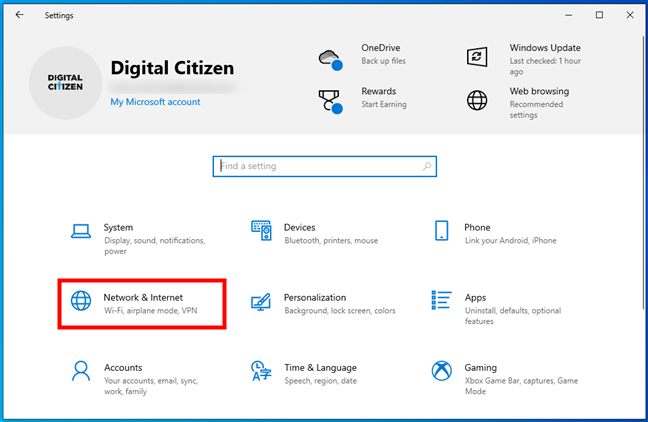
The Network & Internet settings in Windows 10
On the left sidebar, select your network type. If you’re using a wireless card, click or tap on Wi-Fi. If you’re using a wired connection, go to Ethernet. On the right side of the window, click or tap on the name of your network connection.
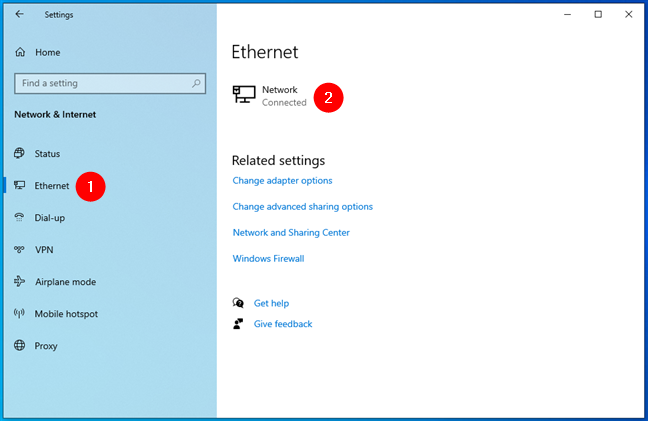
The currently connected network
Scroll down on your network connection details page until you find the section called IP settings. Then, click or tap on Edit, under IP assignment.
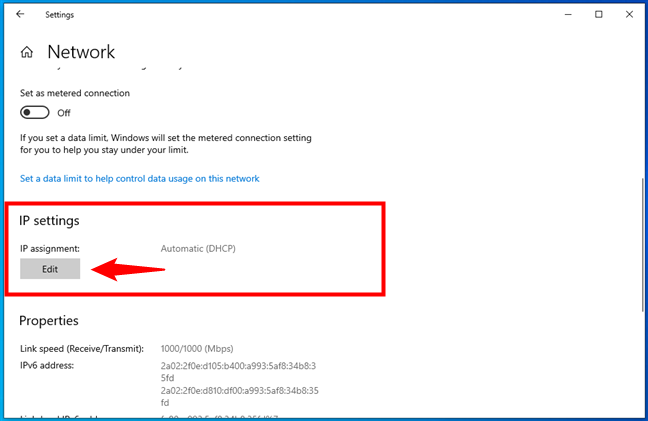
The Edit button from the IP assignment area
The Settings app now shows the “Edit IP settings” dialog. This is where you can change the IP address of your computer or device. If you want the IP address of your Windows 10 PC to be assigned automatically by your router, select Automatic (DHCP). This is also called a dynamic IP address.
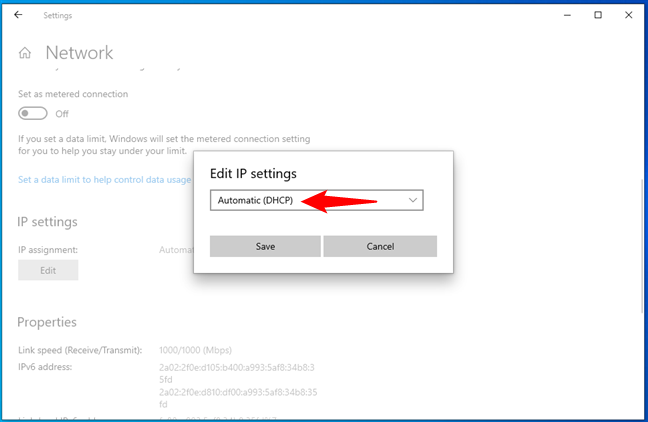
Edit IP settings to get an IP address automatically via DHCP
If you want to set your own static IP address, select Manual and then enable the IPv4 and/or IPv6 switches, depending on what internet protocols you want to use. Note that each of them has its own distinct IP address, so you must enter the required details for both IPv4 and IPv6 if you choose to enable both.
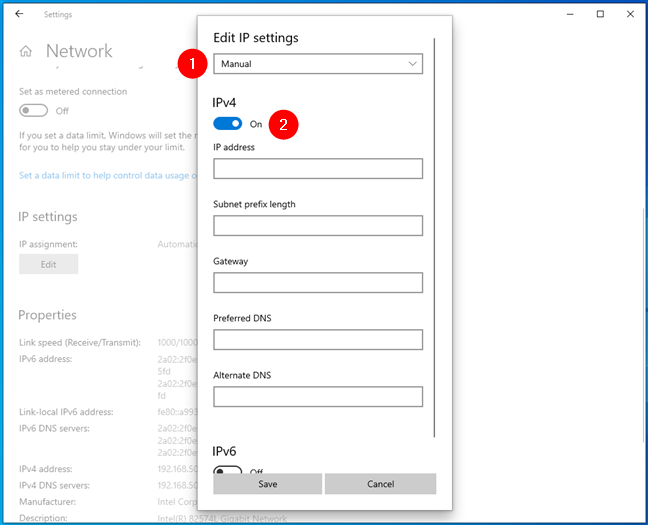
Edit IP settings to change the IPv4 address in Windows 10
To change your IP address to a static one, regardless of whether you set it for your IPv4 or IPv6 protocols, you have to enter the following details:
- IP address: Type the static IP address that you want to use. For example, I want to change the IP address (IPv4) of my Windows 10 PC to 192.168.50.10.
- Subnet prefix length: Type the prefix length that determines the size of the subnet. For example, I configured my router to use a subnet mask of 255.255.255.0, which means that I have to enter a “Subnet prefix length” of 24 (the number of 1 bits in the netmask). If I had a subnet mask of 255.255.0.0, the prefix length would have been 16, and so on.
- Gateway: Type the IP address of your router. In my case, that’s 192.168.50.1.
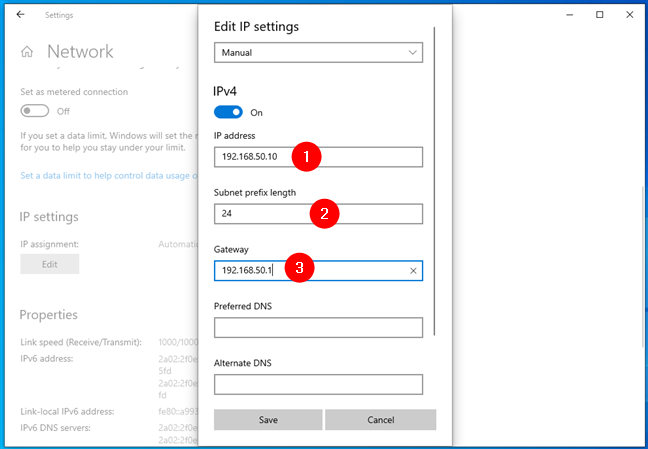
Setting a static IP address in Windows 10
The Preferred DNS and Alternate DNS settings are not mandatory — if you leave them blank, they are automatically assigned by your router. However, if you want to change them too, you can do so. TIP: Here are more ways to change DNS settings in Windows.
Once you’ve entered all the details, click or tap on Save, and Windows 10 changes your IP address.
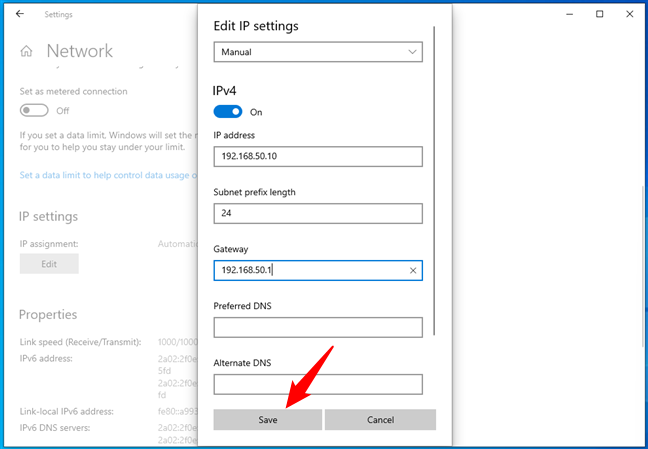
Start using the new IP address in Windows 10
IMPORTANT: If you choose to use a static IP address, ensure all the details you enter are correct; otherwise, your Windows 10 PC loses internet connectivity. If that happens, change your IP address back to Automatic (DHCP) so that your router can change it to something that works.
2. How to change the IP address in Windows 11 using the Settings app
As it involves mainly clicks or taps and anyone can follow its steps, this is likely the easiest way of changing the IP address of your Windows 11 PC. Here’s how it goes:
Open the Settings app: a quick way to do that is to use its Pinned shortcut from the Start Menu or press Windows + I on your keyboard. Once you’ve opened it, select Network & internet on the left sidebar.
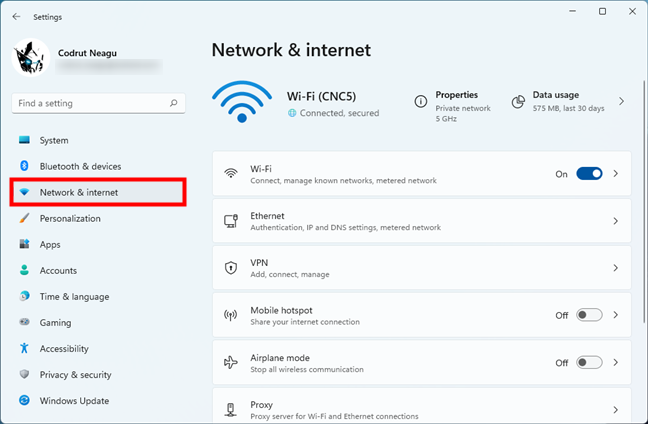
The Network & internet settings in Windows 11
On the right, click or tap on the type of network you’re currently using. If you connect to the internet (or local area network) using a wireless card, select Wi-Fi. If you’re accessing the internet (or LAN) using a wired connection, click or tap on Ethernet.
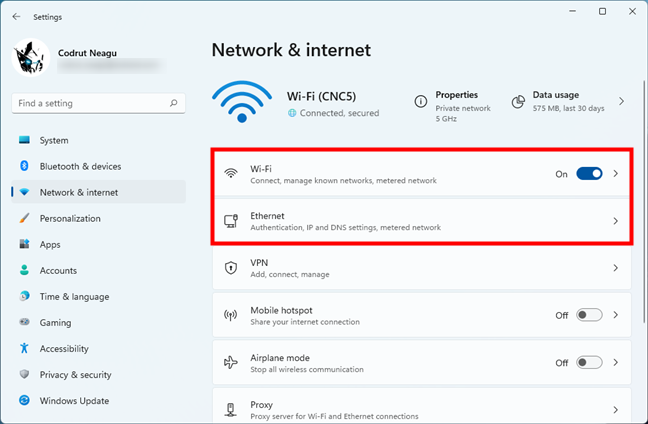
Wi-Fi or Ethernet network connection
Next, click or tap on the properties entry of your network connection.
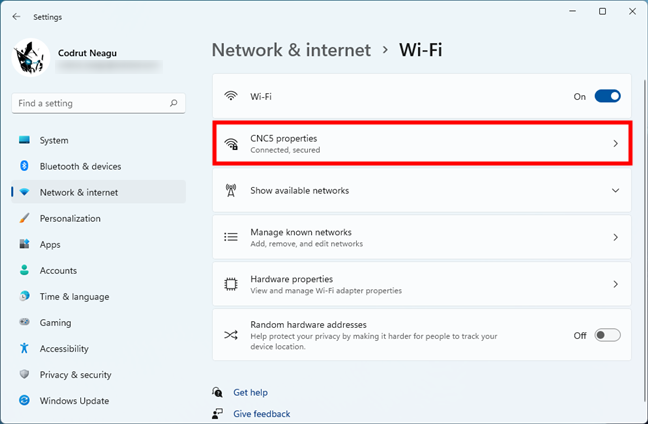
The network’s properties
This opens a page filled with details about the selected network connection. On it, scroll down and click or tap the Edit button next to IP assignment.
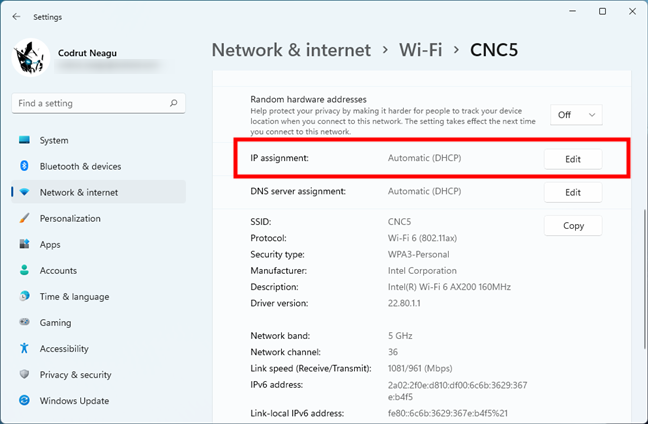
The Edit button next to IP assignment
As a result, the Settings app loads a dialog called “Edit network IP settings,” where you can set the IP address of your Windows 11 PC. If you want to use a dynamic IP address assigned automatically by the router, choose Automatic (DHCP).
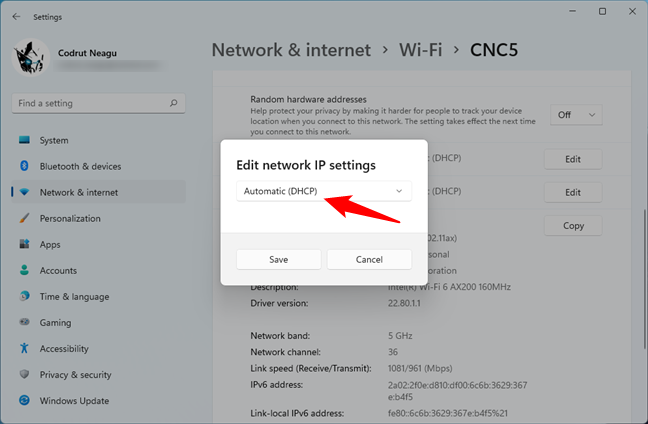
Let Windows 11 get an IP address automatically via DHCP
If you want to set a static IP address for your Windows 11 computer, select Manual. Then, turn on the IPv4 and/or IPv6 switches, depending on the internet protocols you intend to use. Keep in mind that each one needs a distinct IP address, so you’ll have to specify details for both IPv4 and IPv6 if you decide to enable both.
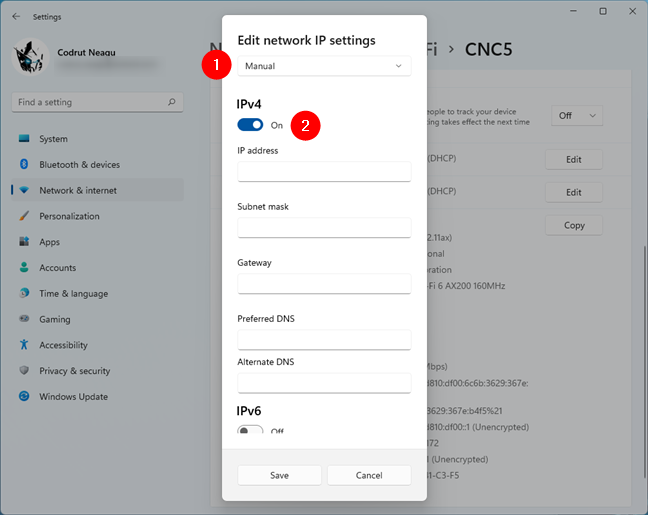
Edit IP settings to change the IPv4 address in Windows 11
In order to set a static IP address for either IPv4 or IPv6, you have to provide the next details:
- IP address: Enter the static IP address you want to use. For instance, I’m changing the IP address (IPv4) of my Windows 11 computer to 192.168.50.10.
- Subnet mask: Type the subnet mask used by your network. For example, I’ve configured my mesh Wi-Fi to use a 255.255.255.0 subnet mask, which means that this is the number sequence I need to enter.
- Gateway: Specify the IP address of your router or mesh Wi-Fi. In my case, that’s 192.168.50.1.
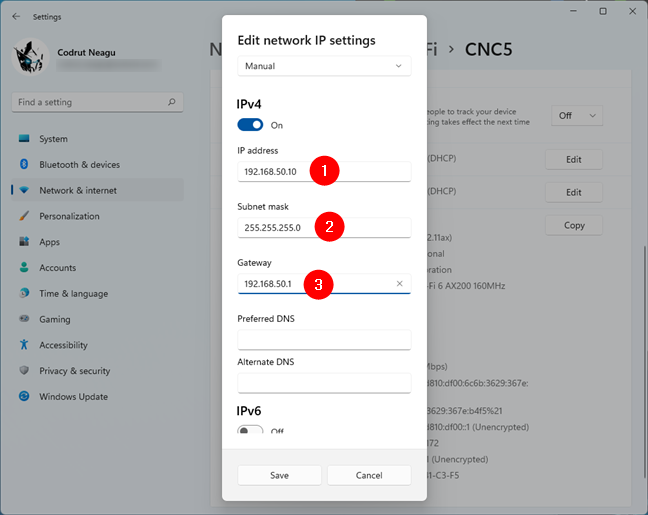
Setting a static IP address in Windows 11
These are all the settings you need to configure in order to change your IP address in Windows 11. However, there are two more options in the “Edit network IP settings” dialog: Preferred DNS and Alternate DNS. While not necessarily required (if they’re blank, your router automatically assigns them), you can change them, too, if you want. Here are more details about DNS: What is DNS? How is it useful?.
Once you’ve finished editing your network IP settings, click or tap the Save button, and your IP address is immediately changed in Windows 11.
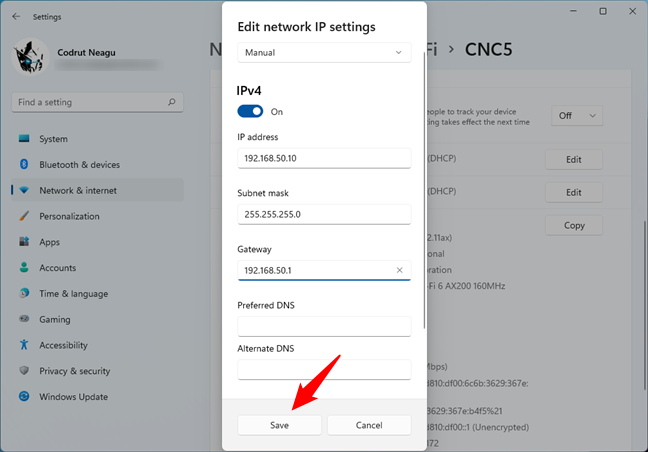
How to set a static IP address in Windows 11
IMPORTANT: If you’ve changed your IP address and your Windows 11 PC lost internet connectivity, you’ve probably entered an incorrect IP address. In that case, switch back to using Automatic (DHCP) to let your router assign a new one for your computer, one that works.
3. How to change the IP address in Windows using the Control Panel
In both Windows 11 and Windows 10, you can also change your IP address from the Control Panel. Open the Control Panel and click or tap on “View network status and tasks” under “Network and Internet.”
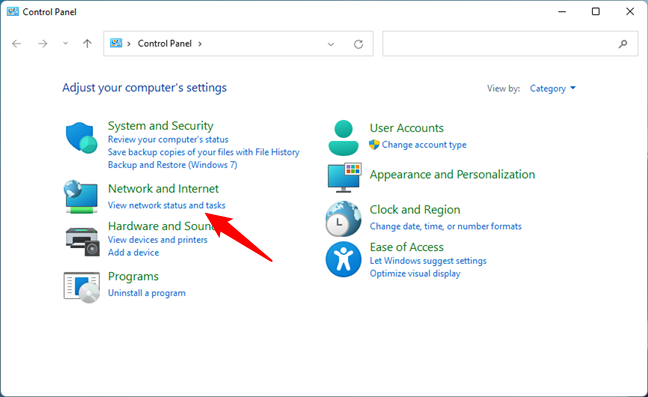
View network status and tasks in Control Panel
In the Network and Sharing Center, click or tap on your internet connection from the “View your active networks” area.
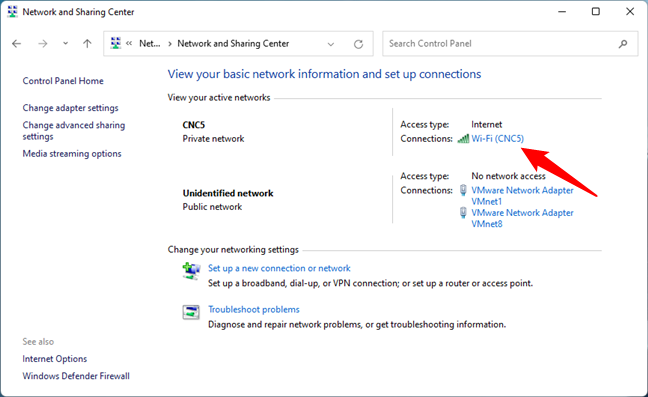
The network connection in use
In your network’s Status window, click or tap on Properties. Then, in the Properties window, select Internet Protocol Version 4 (TCP/IPv4) or Internet Protocol Version 6 (TCP/IPv6), depending on the IP address that you want to change, and press the Properties button. Note that if you want to change both types of IP addresses, you’ll have to repeat the next steps for each of them.
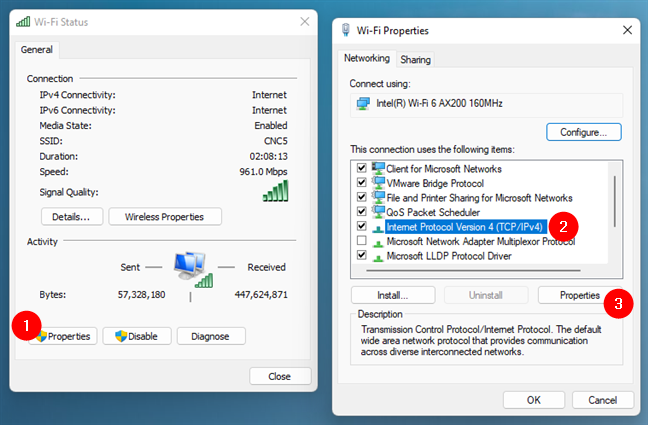
Opening the Properties of Internet Protocol Version 4 (TCP/IPv4)
The previous action opens a window called Internet Protocol Version 4 (TCP/IPv4) Properties or Internet Protocol Version 6 (TCP/IPv6) Properties, depending on what you chose earlier. This is where you can change your IP address:
If you want to use a dynamic IP address that’s automatically assigned to your Windows PC by your router, select “Obtain an IP address automatically.” Then, click or tap on OK and close all the windows you’ve opened previously.
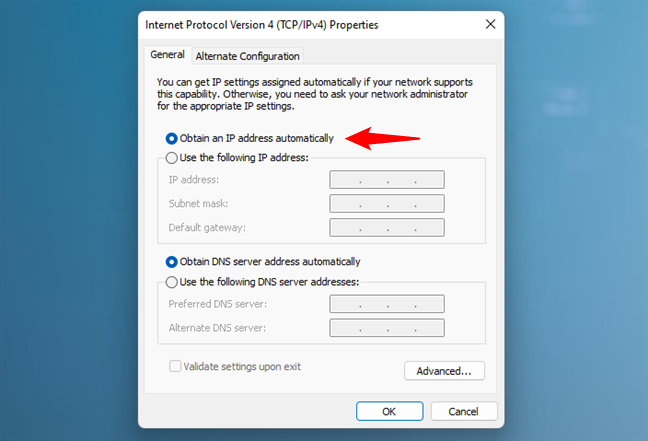
Obtain an IP address automatically via DHCP
If you want to set a static IP address for your network adapter, select “Use the following IP address.” Then, enter the required details manually: IP address, Subnet mask, and Default gateway, just like we’ve shown you in the previous chapters of this guide.
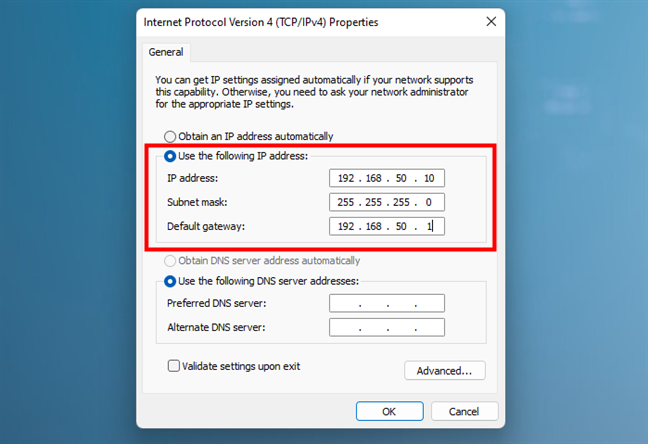
Use Control Panel to set a static IP address in Windows
Save your new IP address settings by clicking or tapping on OK, then close all the windows opened during the process.
4. How to change the IP address in Windows 10 and Windows 11 using commands
You can also change the IP address using any of the command-line tools in Windows. Launch PowerShell, run Command Prompt, or open a tab for any of them in Windows Terminal. Then, regardless of what your favorite console is, run this command:
netsh interface ip show config
In the displayed results, identify the network adapter for which you want to change the IP address. For example, the name of my network interface is Wi-Fi, as shown in the screenshot below.
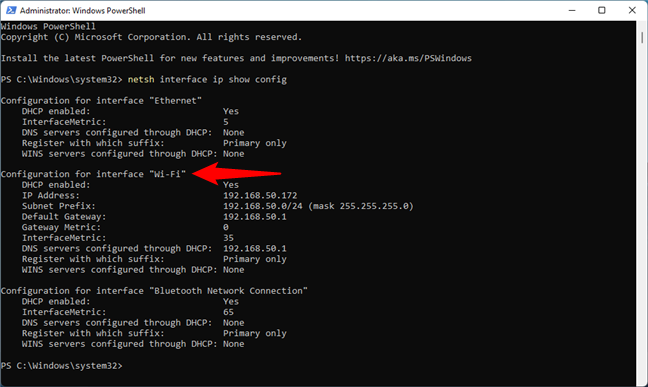
Find the name of your network adapter in CMD or PowerShell
If you want to change the IP address to a dynamic one that’s automatically assigned by your router via DHCP, run the following command:
netsh interface ip set address “Network Interface Name” dhcp
Replace Network Interface Name with the name of your network connection. For example, I need to run:
netsh interface ip set address “Wi-Fi” dhcp
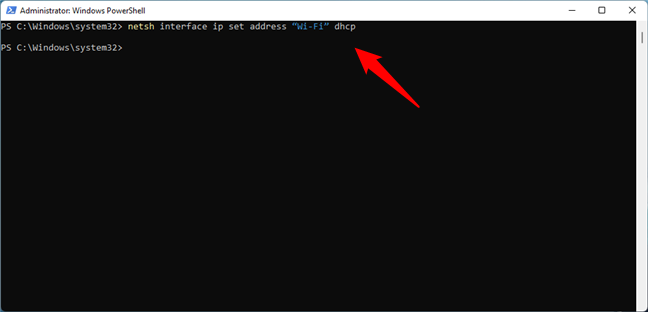
Use this command to set a dynamic IP address
If you want to set a static IP address, run this command:
netsh interface ip set address name= “Network Interface Name” static [IP address] [Subnet Mask] [Gateway]
Replace [IP address] [Subnet Mask] [Gateway] with the ones that match your network configuration. In my case, as I want to change my IP address to 192.168.50.10, I have to run:
netsh interface ip set address name=“Wi-Fi” static 192.168.50.10 255.255.255.0 192.168.50.1
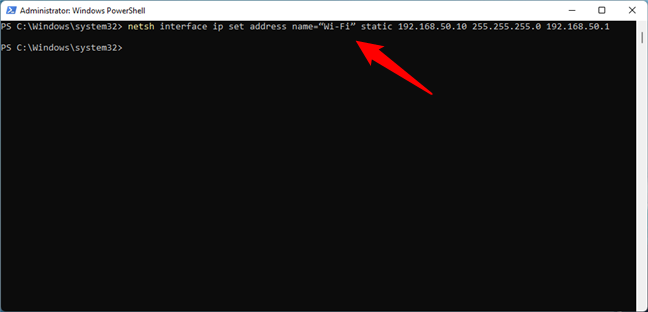
Use this command to set a static IP address in CMD or PowerShell
That’s it!
How do you change the IP address in Windows 10 or Windows 11?
Now you know not just one, but four different methods to change your IP address and set it to dynamic or static. What’s your favorite way of doing this? Do you know other methods? If you do, or if you have something to add to this guide, don’t hesitate to comment.
